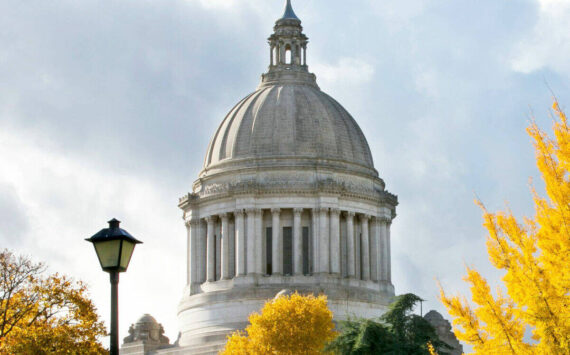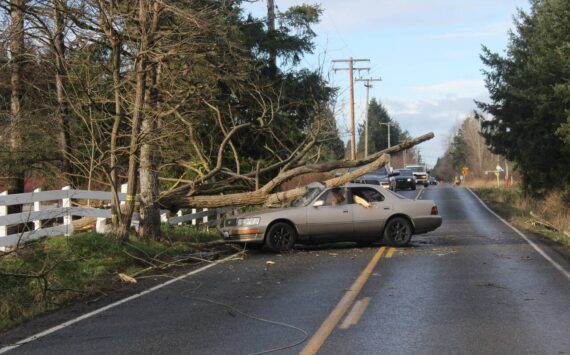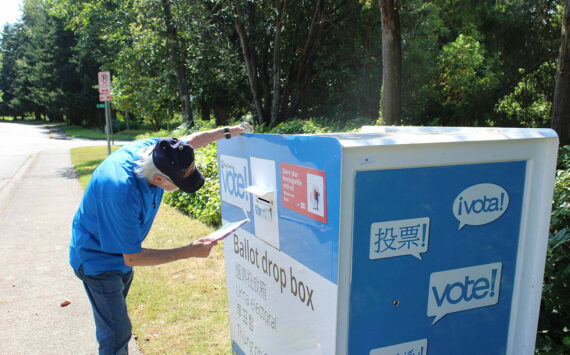On many levels, it is fitting that the Washington Trust for Historic Preservation this week chose Tacoma’s Murray Morgan Bridge to announce its annual list of Washington State’s most endangered historic properties. Representatives of the non-profit, Seattle-based preservation advocacy group were in town Tuesday to reveal this year’s roundup of historic properties that face extinction through demolition and neglect.
The 95-year-old Murray Morgan Bridge, nominated by Historic Tacoma, is an easy entry on this year’s list of eight properties — others include Historic Commercial Fishing Net Sheds (Gig Harbor); Washington Hall (Seattle); Kapus Farmstead (Ridgefield, Clark County); Nuclear Reactor Building (Seattle); Bettinger House (Edmonds); Greyhound Bus Station (Olympia); and Old Granary Building (Bellingham).
In October, the state-owned bridge was closed to vehicular traffic by the Washington State Department of Transportation (WSDOT) because it was deemed unsafe after decades of neglect. Officials estimate it could cost $80 million to rehabilitate the bridge, and $135 million to demolish it entirely and build a new span. Currently, the city and state have identified $40 million to be used for preserving and rehabilitating the bridge. Local officials are working with legislators to secure the other $40 million.
It’s also an iconic emblem on Tacoma’s skyline, in Tacoma’s history. Originally known as the 11th Street Bridge, it was added to the state’s highway system in 1937. In 1997, it was renamed the Murray Morgan Bridge in honor of the late historian and author, who once worked as the bridge’s operator. The bridge is listed on city and national registers.
And its closure has sent the city’s emergency services scrambling for an alternative route to reach Tacoma’s industrial tide flats. According to the City of Tacoma, an additional fire engine was placed in service at Station 2 at additional expense to the city. The engine provides reasonable coverage to the tide flats, and back-up access to downtown and Northeast Tacoma. Similarly, the Tacoma Police Department increased its level of police coverage in the Northeast Tacoma and tide flats areas by providing overtime to six officers.
During the Washington Trust’s press conference Tuesday, several people spoke of the significance of saving the bridge. Here are some of their comments.
1. Bill Baarsma, Mayor, City of Tacoma
This is a stretch, but I was thinking about Ronald Reagan standing before the wall in Berlin and saying, ‘Mr. Gorbachev, tear down this wall!’ I’m standing here saying, ‘State of Washington, reopen this bridge!’ It really is critical.
This is an old bridge, obviously. But we are celebrating the 125th anniversary of the Brooklyn Bridge, which is still sturdy and functional. As our engineers and consultants have told us, this bridge can be restored, renovated, and functional as well.
It was on Feb. 15, 1913, that this bridge was opened. There were 10,000 people here present at the opening of the bridge. The bridge is remarkable and unique in three ways: it is built on a grade, and maybe it’s the only lift bridge built on a grade; it’s deck is unusually high for a vertical lift bridge; and it features an overhead span for carrying a water pipe, which was important for the development of the industrial tidelands.
The historic significance of the bridge is self-evident. We know it is important in terms of its unique characteristics. It’s a one-of-a-kind bridge. But it’s also critical to the City of Tacoma. It’s a lifeline from the industrial area to our first responders. Just up the street is Fire Station No. 1. That fire station has a four-minute response to anything that might happen in the industrial area. Its direct route is through this 11th Street corridor. That’s why not only preserving the bridge but preserving this corridor is critical to the safety and security of the citizens of the City of Tacoma. It’s also been a very costly endeavor for the City of Tacoma because we’ve had to move our fire responders and our police responders, and it’s costing our general fund about $2 million per year to make those adjustments. So in terms of response, safety, and security, this route is critical.
The great urban myth we’ve heard for many years is if we tore this bridge down and built a new bridge, it would save money. That is an urban myth. Restoring and remediating this bridge will save taxpayers about $50 million. It’s about an $80 million project, as compared to a $135 million project to build a new bridge. Also, this bridge is in the center of a Superfund site. To remove the bridge would have all sorts of unintended consequences.
So if you add up the cost benefits, add up the issue of security, add up the importance of the historic structure, all of those things make it very obvious that what we need to do is restore this corridor and make this bridge functional again. We can do it.
We’re halfway there in terms of funding. We’re exploring every opportunity to get all the way there. [The Washington Trust] recognition is important because it lends to the argument we need to make to the Legislature to support and identify the funds to make this bridge whole again.
2. Dennis Flannigan, U.S. State Representative, District 27
It’s funny. Murray Morgan was a friend of mine and we went to lunch one time. It wasn’t called the Murray Morgan Bridge then. It was called the 11th Street Bridge. I asked him about the bridge, and he said, ‘Yeah, I worked there a couple weeks.’ He told me about the first time he had to raise it. Many people know this story, but the truth is Murray Morgan was a student at one of the local universities, and he was working and doing his homework up there. For the first and only time he ever raised the bridge, he heard a toot and thought, ‘My gosh, I better do what I’m paid to do.’ So he raised the bridge. Murray told me he forgot to lower the barriers to keep cars from driving off. That, he thought, wasn’t a good idea. And then it took six days to get it down. That was his last day working on the 11th Street Bridge. So we’ve named a bridge after one of the great historians of the Pacific Northwest, but I wouldn’t hire him to be a bridge tender. That’s Murray’s story to me over lunch one day.
I’ve been on this bridge a lot. But it’s been a long time since I’ve [had a sense] of the magnificence of what we can preserve. It isn’t just the bridge. It’s all of the history of the industrial life of this city, which is just a walk across this bridge. It is a sadness that a bridge in such disrepair must be preserved. I feel it is the state’s obligation because it was the state who we gave the bridge to on the promise that this bridge would never look like this. It would never be a bridge that you could not cross. And it would be returned by the contract to the City of Tacoma, if it ever wanted it, in exactly the state that they took the bridge. As a state employee and a legislator, I want to help all legislators understand it is the word of the state that is at stake here. People say, ‘Well, only 4,000 people cross this bridge each day.’ It is not right now a transportation bridge. It is a bridge of access to the industrial area. Imagine, with that side of the bridge as economically viable and prosperous as this side of the bridge, what we can do again.
3. Chris Moore, Field Director, Washington Trust for Historic Preservation
One of the key things about this year’s listing is the fact that the Murray Morgan Bridge represents what is truly not just a statewide issue but a national issue of infrastructure specifically related to our historic bridges. This was obviously brought to light in August of last year with the tragic collapse of Interstate 35 in Minneapolis. It certainly highlights the issue of infrastructure safety. Here in Washington, according to the state department of transportation, there are over 120 state-owned bridges that are categorized as structurally deficient. That doesn’t mean they are going to crumble the next day. But they certainly are in need of repairs or have a certain issue that puts them in that category. The Murray Morgan Bridge is one of those, which is the reason it is closed now. Hopefully, what we can do with this listing is not only work to affect a good positive outcome for the bridge in terms of its restoration and rehabilitation, and it can continue to serve as a corridor and a link between downtown and the waterfront. But [we also hope to] highlight the issue our historic structures face around the state.







